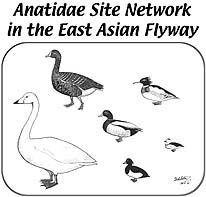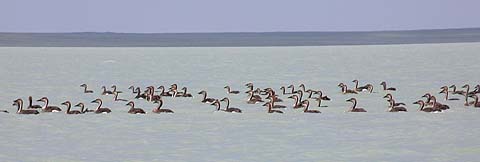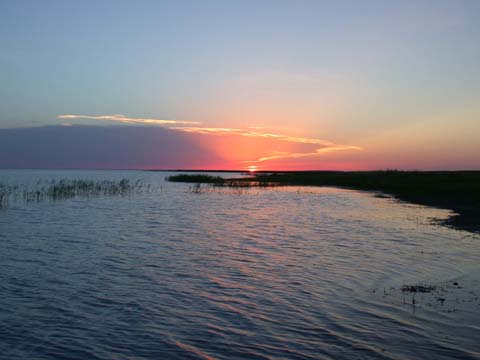
Importance of Torey Lakes for Swan Goose
from Anet Newsletter No.3, page 6 (November 2002)
All the pictures were provided by Daursky Nature Reserve
[ in Japanese ] [ Back ]
[ What's New ] |
[ Site Network ] |
[ Action Plan ] |
[ Links ] |
[ Atlas ] |
[ Sitemap ] |
[ Japanese pages ] |
[ Network Sites ] |
[ Activities ] |
[ Introduction ] |
[ Contacts ] |
|
|
Importance of Torey Lakes for Swan Goosefrom Anet Newsletter No.3, page 6 (November 2002) All the pictures were provided by Daursky Nature Reserve [ in Japanese ] [ Back ] |
|
Torey Lakes provides a representative example of natural wetlands of the Mongol-Manzurian steppe with the largest enclosed soda lakes in the Trans-Baikal area of Chita Oblast' in Russia, near the border with Mongolia. It consists of two large lakes of Barun-Torey and Zoon-Torey, and terrestrial steppe ecosystems. It has been designated as Ramsar site since 1994 (172,500 ha, 49°55' - 50°14'N, 115°05' - 115°58'E), as well as UNESCO Man and Biosphere Reserve (1997), Crane Network Site (1997) and Anatidae Network Site (1999). It important for staging Anatidae during their migration including c. 2,500 geese, 5,000 shelducks, 20,000 ducks, and Swan Goose and Baer's Pochard in breeding and moulting, as well as other waterbird species such as coots, cranes and gulls. The steppe consists of Festuca, Koeleria, Stipa vegetations; lakes are dominated by Potamogeton and other water plants, with freshwater wetlands with Phragmites etc. It also includes pine forest and rangelands. The site has been monitored as Terrestrial Ecosystem Monitoring Sites of FAO since 1997. The Daursky Zapovednik (44,752 ha) has been established around Lake Barun-Torey since 1987, and it composes the Dauria International Protected Area with the Mongol-Daguur Zapovednik (Mongolia) and the Dallay-Nor Nature Reserve (China). |
|||||||||||||||

The Daursky Zapovednik has joined in the Swan Goose survey under the international cooperation of Russia and Japan since 2001 (Poyarkov & Kurechi 2001, Goroshko 2001). In 2001, 500-700 individuals including c.100 pairs were counted in breeding season in the Torey Lakes, and 1,840 birds gathered in autumn before their southward migration in second half of September. In early September of 2002, 2,369 individuals were counted (Goroshko, pers. comm. 2002). Part of large flock in 2002 autumn was likely to have moved from breeding area in north-eastern Mongolia. It suggests the international importance of the Torey Lakes for the Swan Goose with supporting 4.7-7.9% of the population proposed in the 1999 Anatidae Atlas (Miyabayashi & Mundkur 1999).
The conservation efforts of this globally threatened species has been initiated under the Anatidae Action Plan: 2001-2005 (Asia Pacific Migratory Waterbird Conservation Committee 2001). Mr. Oleg Goroshko in the Zapovednik was nominated to a member of the Swan Goose Task Force. It is anticipated that the Zapovednik contributes to this international initiative.

Literature cited
Asia Pacific Migratory Waterbird Conservation Committee. 2001. Asia-Pacific Migratory Waterbird Conservation Strategy: 2001-2005. Wetlands International - Asia Pacific, Kuala Lumpur, Malaysia, 67pp. [on-line] http://www.ea.gov.au/water/wetlands/mwp/2001-2005/
Goroshko, O.A. 2001. Swan Goose in the eastern Transbaikalia and Mongolia. Casarca 7: 68-98. in Russian with English summary
Miyabayashi, Y. & Mundkur, T. 1999. Atlas of Key Sites for Anatidae in the East Asian Flyway. Wetlands International - Japan, Tokyo, and Wetlands International - Asia Pacific, Kuala Lumpur. 148pp. [on-line] http://www.jawgp.org/anet/aaa1999/aaaendx.htm
Poyarkov, N.D. & Kurechi, M. 2001. Russian - Japanese swan goose conservation programme. TWSG News No.13: 74-76. [on-line] http://www.wwt.org.uk/threatsp/twsg/bulletins/13/f19.htm
[ Top ] [ in Japanese ] [ Back ]
[ Network Sites ] |
[ Activities ] |
[ Introduction ] |
[ Contacts ] |
[ What's New ] |
[ Site Network ] |
[ Action Plan ] |
[ Links ] |
[ Atlas ] |
[ Sitemap ] |
[ Japanese pages ] |